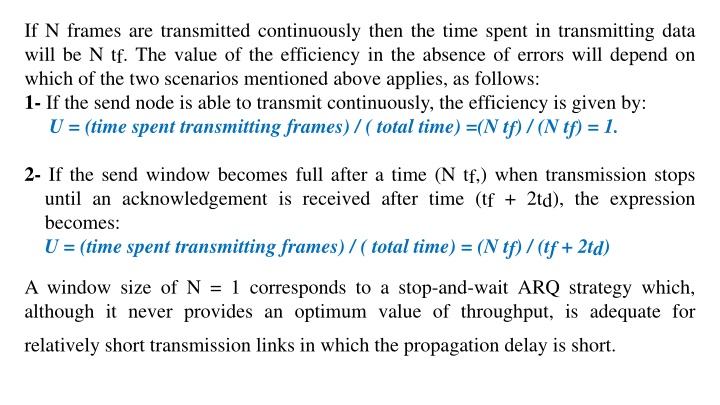
Efficiency and Throughput in Data Communication Systems
Learn about the efficiency and throughput calculation in data communication systems considering transmission delays, frame lengths, window sizes, and error rates. Explore how different scenarios impact the overall data transfer performance.
Download Presentation

Please find below an Image/Link to download the presentation.
The content on the website is provided AS IS for your information and personal use only. It may not be sold, licensed, or shared on other websites without obtaining consent from the author. If you encounter any issues during the download, it is possible that the publisher has removed the file from their server.
You are allowed to download the files provided on this website for personal or commercial use, subject to the condition that they are used lawfully. All files are the property of their respective owners.
The content on the website is provided AS IS for your information and personal use only. It may not be sold, licensed, or shared on other websites without obtaining consent from the author.
E N D
Presentation Transcript
If N frames are transmitted continuously then the time spent in transmitting data will be N tf. The value of the efficiency in the absence of errors will depend on which of the two scenarios mentioned above applies, as follows: 1- If the send node is able to transmit continuously, the efficiency is given by: U = (time spent transmitting frames) / ( total time) =(N tf) / (N tf) = 1. 2- If the send window becomes full after a time (N tf,) when transmission stops until an acknowledgement is received after time (tf + 2td), the expression becomes: U = (time spent transmitting frames) / ( total time) = (N tf) / (tf + 2td) A window size of N = 1 corresponds to a stop-and-wait ARQ strategy which, although it never provides an optimum value of throughput, is adequate for relatively short transmission links in which the propagation delay is short.
A window size of 5 is adequate for most terrestrial links but in the case of links which have large propagation delays, such as satellite systems, a large window size is required to produce a satisfactory throughput (127 being a typical window size for such systems). Example 1: A frame oriented data communications system operates at a transmission rate of 512 kbps with a frame length of 512 bytes and 506 information bytes in each frame over a long-distance link which produces a propagation delay of 20 ms. A flow control system is required using a go- back-3 ARQ flow control (with a window size of 3), determine: (a) the efficiency, (b) the throughput obtained on an error-free link, (c) the throughput for a BER of 0.00003.
Solution: Frame length, n = 512 bytes. Information bits, k = 506 bytes. Delay time, td = 20 ms. Frame transmission time, tf = 8 ms. Window size, N = 3. (a) We know from the previous example in lecture 14, that the sending window becomes full before an acknowledgement is received (since N is less than 6) and the efficiency is not optimized. Under these circumstances, the efficiency is given by: U = (N) / (1 + 2a) where a = td / tf = 20 / 8 = 2.5 therefore: Efficiency (U) = (3) / (6) = 0.5 which has the percentage value of 50%.
(c) In the absence of errors, the throughput is given by: Throughput = (No. of Information bits transmission) / (Total time taken). = (Nk) / (tf + 2td) = (3 x 506 x 8) / (8 + 40) x 10-3 = 253 Kbps. (d) Bit error rate, E = 3 x 10-5 = 0.00003. Frame error probability is given by: P = 1 (1 E)n = 1 (1 0.00003)4096 = 0.11563. The effect of errors and the go-back-3 ARQ strategy will be for frames to be retransmitted. The average number of transmissions, m, is given as: m = (1 +NP) / (1 P) = (1 +(3 * 0.11563)) / (1 0.11563) = 1.52299 The total time taken by the data transfer will be increased by this amount, giving a value for throughput as follows: Throughput = (Nk) / m (tf + 2td) = (253) / (1.52299) = 166.12059 Kbps. The throughput has been reduced to under half the transmission rate.
Example 2: If the signal rate is 100 Mbps and frame length is 2000 bits, calculate the value ofThe factor (a = td / tf) for the following medium lengths: (a)250m. (b)4000m. Assume signal propagation, typical of twisted-pair cable, to be 2 108 m/s. Solution: (a) The factor a is given by: a = (Propagation delay) / (Frame transmission time) Propagation delay = (250 m) / (2 x 108 m/s) = 1.25 s. Frame transmission time = (No. of frame bits) / (Signal rate) = (2000 bits) / (100 Mbps) = 20 s. Therefore: a = td / tf = 1.25 / 20 = 0.0625. (b) If the medium length is changed from 250 m to 4000 m then a is increased by (4000 / 250) or 16 times. Hence a becomes 1, which would lead to a marked deterioration in throughput under heavy-load conditions.



















